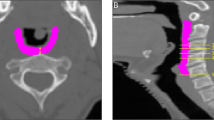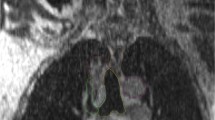Abstract
Background
Accelerated radiotherapy and/or chemo-radiotherapy of the head and neck region decrease the tolerance of acute responding tissues. Tissue tolerance is also field size dependent.
Patients and Method
An attempt to retrospectively quantify the risk of acute toxicity (peak scores) with field size was undertaken in 286 patients irradiated for unresected head and neck tumors with or without chemotherapy, and with or without accelerated radiotherapy between 1979 and 1990. A Grade-3 to -4 acute toxicity score (RTOG) and > 5% weight loss were chosen as endpoints.
Results
For Grade-3 to -4 toxicity, the risk increased from 0.06 for 5 x 5 cm2 to 0.68 for 17 x 17 cm2 fields and conventional radiotherapy, and from 0.33 for 5 x 5 cm2 to 0.94 for 17 x 17 cm2 and multiple daily fractionation. For > 5% weight loss, the risk ranged from 0.07 for 5 x 5 cm2 to 0.94 for 17 x 17 cm2 fields.
Conclusions
The size of the cervical fields receiving the first 50 Gy was an indicator for severe acute toxicity and weight loss. Taking these data into account may help to improve preventive and treatment measures.
Zusammenfassung
Hintergrund
Im Hals-Nasen-Ohren-Bereich vermindern sowohl die akzelerierte Fraktionierung als auch die zusÄtzliche Chemotherapie die akute Toleranz der Strahlentherapie, welche ebenfalls von der Feldgrö\e beeinflu\t wird.
Patienten und Methode
Das Ziel dieser Arbeit war es, in AbhÄngigkeit vom Fraktionierungsschema und dem Einsatz einer Chemotherapie bei 286 bestrahlten, nichtoperierten Patienten mit Larynxoder Pharynxkarzinomen den Einflu\ der Feldgrö\e auf die akute MorbiditÄt quantitativ zu untersuchen. Als Endpunkte wurden die akute ToxizitÄt RTOG-Grad 3 bis 4 und > 5% Gewichtsverlust festgehalten.
Resultate
Bezüglich akuter ToxizitÄt Grad 3 bis 4 nahm das Risiko bei einer monofraktionierten Bestrahlung von 0,06 für 5 x 5 cm2 bis auf 0,68 für 17 x 17 cm2 Feldgrö\en und von 0,33 für 5 x 5 cm2 bis auf 0,94 für 17 × 17 cm2 Feldgrö\en im Falle von mehreren Bestrahlungssitzungen pro Tag zu. In bezug auf > 5% Gewichtsabnahme variierte das Risiko zwischen 0,07 für 5 x 5 cm2 und 0,94 für 17 x 17 cm2 Feldgrö\en.
Schlu\folgerungen
Die Grö\e der Felder, über welche die ersten 50 Gy eingestrahlt wurden, korrelierte signifikant sowohl mit schwerer akuter ToxizitÄt als auch mit Gewichtsabnahme (Tabelle 1). Diese Daten könnten künftig bei der Auswahl von Hochrisikopatienten von Nutzen sein, um die frühzeitige Anwendung prÄventiver Ma\nahmen zur Verminderung der akuten MorbiditÄt bei der Bestrahlung im HNO-Bereich zu bedenken.
Similar content being viewed by others
References
Allai AS, Miralbell R, Pipard G, et al. Early and long-term results of an original accelerated radiation therapy schedule in head and neck carcinoma. Acta Oncol 1997;36:267–71.
Allai AS, Bieri S, Miralbell R, et al. Combined concomitant boost radiotherapy and chemotherapy in stage-III–IV head and neck carcinomas: A comparison of toxicity and treatment results with those observed after radiotherapy alone. Ann Oncol 1997;8:681–4
Barendsen GW. Dose fractionation, dose rate and isoeffect relationships for normal tissue response. Int J Radiat Oncol Biol Phys 1982;8:1981–97.
Dale RG. Time-dependent tumor repopulation factors in linear-quadratic equations. Implications for treatment strategies. Radiother Oncol 1989; 15:371–82.
Douglas BG. Implications of the quadratic cell survival curve and human skin radiation “tolerance doses” on fractionation and superfracdonation dose selection. Int J Radiat Oncol Biol Phys 1982;8: 1135–42.
Horiot J-C, Bontemps P, Bogaert W van den, et al. Accelerated fractionation (AF) compared to conventional fractionation (CF) improves loco-regional control in the radiotherapy of advanced head and neck cancers: results of the EORTC 22851 randomized trial. Radiother Oncol 1997;44: 111–21.
Jackson SM, Weir LM, Hay JH, et al. A randomised trial of accelerated versus conventional radiotherapy in head and neck cancer. Radiother Oncol 1997;43:39–46.
Leyvraz S, Pasche P, Bauer J, et al. Rapidly alternating chemotherapy and hyperfractionated radiotherapy in the management of locally advanced head and neck carcinoma: Four-year results of a phase-I/II study. J Clin Oncol 1994;12:1876–85.
Orton CG, Cohen L. A unified approach to dose-effect relationships in radiotherapy. I: Modified TDF and linear quadratic equations. Int J Radiat Oncol Biol Phys 1988;14:549–56.
Overgaard J, Sand Hansen H, Overgaard M, et al. Conventional radiotherapy as primary treatment of squamous cell carcinoma of the head and neck. A randomized multicenter study of 5 versus 6 fractions per week. Report from the DAHANCA 7 trial. Int J Radiat Oncol Biol Phys 1997;39 Suppl:188.
Paterson R. Influence of tolerance on choice of dose. In: Arnold E, ed. The treatment of malignant disease by radium and x-rays. London: Publishers Ltd, 1948:39.
Perez CA, Brady LW. Overview. In: Perez CA, Brady LW, eds. Principles and practice of radiation oncology. Philadelphia: Lippincott, 1992:51–5.
Wang CC, Blitzer PH, Suit HD. Twice-a-day radiation therapy for cancer of the head and neck. Cancer 1985;55:2100–4.
Weissler MC, Melin S, Sailer SL, et al. Simultaneous chemoradiation in the treatment of advanced head and neck cancer. Arch Otolaryngol Head Neck Surg 1992;118:806–10.
Author information
Authors and Affiliations
Corresponding author
Rights and permissions
About this article
Cite this article
Miralbell, R., Allal, A.S., Mermillod, B. et al. The influence of field size and other radiotherapy parameters on acute toxicity in pharyngolaryngeal cancers. Strahlenther Onkol 175, 74–77 (1999). https://doi.org/10.1007/BF02753846
Received:
Accepted:
Issue Date:
DOI: https://doi.org/10.1007/BF02753846




